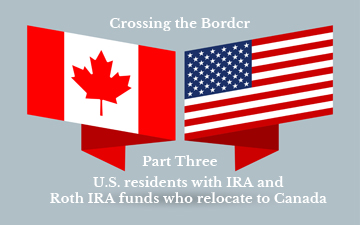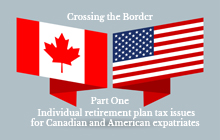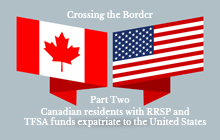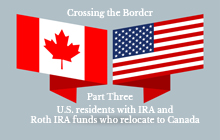Crossing the border, part three: Individual retirement plan tax issues for Canadian and American expatriates

In the final part of a three-part series on cross-border tax issues, Professor George Gonzalez looks at tax situations in which U.S. residents with IRA and Roth IRA funds relocate to Canada
 |
George Gonzalez, PhD is Associate Professor at the Calgary campus of the University of Lethbridge. He is a Chartered Professional Accountant (CPA, CA, Ontario) and a Certified Public Accountant (CPA, Florida). |
THIS is the third of three articles in a series on Canadian and U.S. cross-border tax issues related to individual employee retirement plans. In the last article we reviewed the situation in which a Canadian resident with RRSP and TFSA funds expatriates to the United States. In this article we explore the reverse situation: a U.S. resident with IRA and Roth IRA funds relocates to Canada.
III. Situation #2: A U.S. Resident with IRA and Roth IRA Funds Expatriates to Canada
Topics covered in this section:
A. U.S. Expatriation Tax
B.1. U.S. Taxation of a Canadian Resident’s IRA
B.2. U.S. Taxation of a Canadian Resident’s Roth IRA
C.1. Canadian Taxation of an IRA
C.2. Canadian Taxation of a Roth IRA
D. Transfer of Funds from a RRSP to an IRA or from a TFSA to a Roth IRA
E. U.S. Information Reporting for RRSPs and TFSAs
F. Canadian Information Reporting for RRSPs and TFSAs
III.A. U.S. Expatriation Tax
The U.S. has their own version of a departure tax, called the expatriation tax, in which the expatriating individual’s property is deemed to have been disposed of at fair market value on the date of expatriation, and capital gains and losses calculated accordingly. These rules apply to U.S permanent residents who become non-residents as well as to U.S. citizens who renounce their citizenship. On the other hand, a U.S. citizen who becomes a non-resident (and does not renounce citizenship) is not subject to the expatriation tax. Under U.S. tax law, such taxpayers will continue to be taxed on their worldwide income regardless of their residency[1].
Thus, a Canadian who is a non-citizen resident of the U.S. and repatriates to Canada, becoming a non-resident of the U.S., would be subject to the expatriation tax rules. A dual Canadian/U.S. citizen, however, would not be subject to the expatriation tax if that individual keeps their U.S. citizenship.
The details of the U.S. expatriation tax are beyond the scope of this article. However, a few comments about the tax are noteworthy, as it differs from the Canadian departure tax in a few key respects. One is that, unlike the Canadian departure tax, which is applicable regardless of income or net worth, the U.S. expatriation tax is applicable only to individuals with (a) income in a high tax bracket and/or (2) a high net worth[2]. A second key difference is that, while several types of property are exempt from the Canadian departure tax, with a few special exceptions all of a U.S. individual’s property is subject to the tax.
Accordingly, it would be prudent for a non-citizen U.S. resident individual who plans to become a non-resident (or a citizen who is planning to renounce), to determine their expatriation tax exposure and engage in tax planning to mitigate the tax.
III.B.1. U.S. Taxation of a Canadian Resident’s IRA
Contribution Phase – IRA: An individual is allowed to contribute to an IRA if they have earned income during the year that is subject to U.S. taxation, which would be the case if the individual was a U.S. citizen but typically not if they were a non-citizen, non-resident of the U.S. If a contribution is allowable, it may or may not be deductible depending on several factors. Among these are: the individual’s filing status; income for the year; whether they were covered under an employer-sponsored plan; the extent to which they had earned income excluded under the Foreign Earned Income Exclusion, etc.
Accumulation Phase - IRA: The same taxation rules applicable to a U.S. resident apply to non-residents: income earned within an IRA account is not taxable.
Distribution Phase – IRA: A distribution from a non-resident’s IRA is U.S. source income that is subject to U.S. taxation. The amount of tax is dependent on whether the individual is a U.S. citizen. If the recipient is a U.S. citizen, the IRA distribution is reportable in their U.S. income tax return (Form 1040) and there would be regular[3] income tax withholding on the distribution. This withholding will later serve as a credit in the Form 1040 tax return that is filed with the IRS.
On the other hand, if the recipient is a non-resident non-citizen, then non-resident tax withholding would be applied, similar to the non-resident withholding tax under Canadian tax law. The default withholding tax rate on IRA distributions and other forms of income subject to U.S. non-resident tax withholding is 30%; however, under the Canada-U.S. tax treaty (the “Treaty”), the withholding tax rate is reduced. On IRA distributions, it is 15% if the distribution qualifies as a periodic payment and 30% otherwise[4]. Payment of the withholding tax is considered to be the final tax obligation, and filing of a tax return would not be required.
III.B.2. U.S. Taxation of a Canadian Resident’s Roth IRA
Contribution Phase – Roth IRA: An individual may be allowed to contribute to a Roth IRA if they have employment compensation income that is subject to U.S. taxation during the year (excluding any such income that escapes taxation under the Foreign Earned Income Exclusion). This would apply if the individual was a U.S. citizen but would typically not apply if the individual was a non-citizen, non-resident of the U.S., as they would not be subject to U.S. taxation on their employment compensation income. If a contribution is allowable, it would nonetheless not be deductible, in line with Roth IRA rules.
Accumulation Phase – Roth IRA: The same taxation rules applicable to U.S. citizens and non-citizen, U.S. residents apply to non-citizen, non-residents: income earned within a Roth IRA is not taxable.
Distribution Phase – Roth IRA: The same taxation rules applicable to U.S. citizens and non-citizen, U.S. residents apply to non-citizen, non-residents: distributions from a Roth IRA are tax-free.
III.C.1. Canadian Taxation of an IRA
Contribution Phase – IRA: Contributions to an IRA by a non-resident U.S. citizen are not tax deductible for Canadian tax purposes as there is no provision under Canadian tax law for such a deduction.
Accumulation Phase - IRA: An IRA is considered to be a Foreign Retirement Arrangement (FRA) under Canadian tax law and, as a result, income earned within an IRA is exempt from Canadian income tax while funds accumulate and remain in the retirement account.
Distribution Phase – IRA: Distributions from an IRA and other FRAs are fully taxable by Canada. As discussed under section III.B.1 above, IRA distributions are subject to U.S. taxation as well. To avoid double taxation, a foreign tax credit may be claimed on the Canadian tax return for U.S. taxes paid on the IRA distribution.
Alternatively, if the individual is a U.S. citizen, files a U.S. tax return, and pays U.S. tax on the IRA distribution, a foreign tax credit may be claimed in the U.S. return for the Canadian taxes paid on the IRA distribution. Depending on the individual’s circumstances, it may be more beneficial to claim a foreign tax credit on one return versus the other. It would therefore be judicious to perform calculations under both alternatives to determine the best course of action.
III.C.2. Canadian Taxation of a Roth IRA
Roth IRAs are treated differently under Canadian tax law than IRAs. While an IRA is recognized as a type of FRA, as stated above under III.C.1, Roth IRAs are not. The CRA’s Income Tax Folio S5-F3-C1 (ITF S5-F3-C1) states that a Roth IRA “does not enjoy the income tax deferral benefits afforded under the Act to Canadian registered plans and traditional IRAs. As a result, the income accrued in a Roth IRA is generally taxable in Canada on a current, annual basis.”[5]
Notwithstanding that last sentence, taxation on Roth IRA income accruals can be avoided with a timely and properly filed special election for Roth IRAs. ITF S5-F3-C1 sets forth the details and procedure to be followed for a taxpayer to benefit from this favourable tax treatment. Importantly, ITF S5-F3-C1 states that the election must be filed on or before the individual’s filing due date for the tax year in which the individual became resident in Canada. It is, therefore, critically important to make a timely election to ensure the favourable tax treatment of a Canadian resident’s Roth IRA.
Taking this introductory information into account, we can state the Canadian tax ramifications for a Canadian resident’s Roth IRA in each of the three main phases.
Contribution Phase – Roth IRA: A contribution to a Roth IRA by a Canadian resident is not tax deductible and does not result in an immediate tax ramification. However, no contributions to a Roth IRA must be made after the individual becomes resident in Canada if the favourable Canadian tax treatment described above is to be secured.
Accumulation Phase – Roth IRA: Assuming the aforementioned timely and properly filed election is made, income accrued in the Roth IRA is not taxed. In the absence of a timely and properly filed election, any income that accrues within the Roth IRA will be subject to Canadian taxation, even if exempt from U.S. taxation.
Distribution Phase – Roth IRA: Assuming a timely and properly filed election is made, distributions from a Roth IRA are not subject to Canadian taxation to the extent that they would not be taxable in the U.S. if the individual was a resident of the U.S. In the absence of a timely and properly filed election, the distribution will be treated as a taxable pension distribution.
Presumably, if a Roth IRA distribution is taxable, the portion of the distribution that represents income previously taxed, when it accrued within the Roth IRA, would not be taxed a second time. However, ITF S5-F3-C1 is not clear on this point. Hence, again, the importance of ensuring a timely and properly filed election to gain favourable Canadian tax treatment for a Roth IRA.
III.D. Transfer of Funds from an IRA to a RRSP or from a Roth IRA to a TFSA
IRA to RRSP: In the previous article in this series, it was stated that a transfer of funds from a RRSP to an IRA is not permitted. A transfer in the reverse direction, however, is permitted as an IRA is considered to be a FRA. Thus, it is possible to transfer IRA funds to an RRSP on a tax-deferred basis and without requiring RRSP contribution room, provided certain conditions are met.[6]
There are two important considerations in planning for a transfer of IRA funds to a RRSP. One is that the transfer will be considered a distribution under U.S. tax law, with accompanying tax withholding. As explained under III.B.1. above, the withholding rate will be based on whether the distribution is considered to be a periodic payment. If a periodic payment, the withholding tax rate under the Treaty is 15%, otherwise it is 30%.
The determination of whether the distribution is a periodic payment is at the IRA plan administrator’s discretion. Clearly, if 100% of the funds are transferred, this would not be considered a periodic payment (it will be treated as a lump sum distribution) and the 30% withholding rate would apply. For a distribution that is less than 100% of the funds, the IRA plan administrator’s discretion comes into play. It is therefore recommendable to talk to the IRA plan administrator beforehand to get a sense of what they would consider a periodic payment. This could potentially help ensure a lower withholding tax rate for a periodic payment distribution versus a higher one.
The other key consideration in planning an IRA funds transfer to a RRSP is the necessity to deposit 100% of the distribution in the RRSP in order for the distribution to be completely free of Canadian taxation. An example will help illustrate. Suppose that a non-citizen former U.S. resident with $100,000 in IRA funds becomes a resident of Canada and wishes to transfer 100% of these funds into their RRSP. They instruct the IRA plan administrator to make a 100% distribution. The administrator withholds 30% as the U.S. withholding tax and transfers the $70,000 balance to the individual. If nothing further is done, the taxpayer would include income of $100,000 and a RRSP deduction of $70,000 in their Canadian tax return, resulting in a net amount of $30,000 being taxed.
If the taxpayer wishes to have the full $100,000 distribution escape Canadian taxation, they would need to deposit an additional $30,000 in their RRSP, resulting in a $100,000 RRSP deduction to offset the $100,000 in income in their tax return. This additional contribution to the RRSP would need to be made in the year the IRA funds were distributed (and the net deposited in the RRSP account) or in the first 60 days of the following year. The need to make an additional RRSP contribution of this type, to ensure that none of the IRA distribution gets taxed in the Canadian tax return, may or may not pose a cash flow problem for the taxpayer; this would have to be considered in planning for the distribution.
As part of the planning, the foreign tax credit should also be taken into account. In the above example in which there is a 30% U.S. withholding tax on a $100,000 IRA distribution, the $30,000 foreign tax can be factored into the Canadian tax return calculations. Since the maximum foreign tax credit on passive income allowable in a Canadian individual income tax return is 15% of the foreign income, it is possible that the foreign tax credit will not fully offset the additional Canadian tax. If there is other passive foreign income includable in the Canadian income tax return, it is possible that the foreign tax credit could fully offset the additional Canadian tax incurred, but otherwise the foreign tax credit will not provide a full offset.
If the IRA distribution is considered to be a periodic payment, and the withholding tax therefore 15%, this would make it more likely that the foreign tax credit would fully offset the additional Canadian tax. A tax planning consideration in this regard is to distribute IRA funds over a number of years, rather than all at once, so as to get periodic payment treatment and a 15% withholding tax rate.
Roth IRA to TFSA: A transfer of funds from a Roth IRA to a TFSA is not permitted. However, as discussed under III.C.2. above, if proper and timely procedural steps are taken by an individual who becomes a resident of Canadian, Roth IRA funds will not be taxable by Canada (in addition to not being taxable by the U.S.).
III.E. U.S. Information Reporting for IRAs and Roth IRAs
A taxpayer with funds in an IRA or a Roth IRA does not have any information reporting requirements with respect to holding those funds, although the plan administrator for these may themselves have certain reporting obligations to fulfill.
III.F. Canadian Information Reporting for IRAs and Roth IRAs
IRAs: Funds in a foreign registered pension account, which include IRAs, are not reportable in the Foreign Income Verification Statement (Form T1135), or any other information report.
Roth IRAs: As previously explained under III.C.2., and as described in ITF S5-F3-C1, income that accrues in a Roth IRA is not taxable if the taxpayer has made a timely and properly filed election. ITF S5-F3-C1 also states that if such an election is filed, and no contributions are made to a Roth IRA while the individual is a Canadian resident, then the CRA does not require the filing of foreign information reports for the Roth IRA[7].
Conclusion
In this three-part series we examined cross-border tax issues related to individual employee retirement plans. After reviewing basic information and setting forth the framework for discussion in the first article, in the second article we reviewed the situation in which a Canadian resident with Canadian registered plans expatriates to the United States. This third article discussed the opposite situation, i.e., where a U.S. resident with U.S. qualified plans (IRA and Roth IRA) expatriates to Canada.
As stated at the beginning of this series, a key element for sound tax planning is oftentimes simple awareness of tax issues that may arise for clients. This article series aims to create such awareness with respect to cross-border issues involving RRSPs, TFSAs, IRAs and Roth IRAs.
FOOTNOTES
[1] While a non-resident U.S. individual can benefit from some special international taxation rules, e.g., the Foreign Earned Income Exclusion, they will nevertheless be subject to taxation on worldwide income, i.e., on both U.S. source and foreign source income.
[2] U.S. tax law specifies the income and net worth dollar amount thresholds, which are outside the scope of this article and not discussed.
[3] “Regular” as distinguished from non-resident income tax withholding.
[4] The IRA’s plan administrator has the discretion to determine if a distribution is a periodic payment or not.
[5] Income Tax Folio S5-F3-C1, Taxation of a Roth IRA https://www.canada.ca/en/revenue-agency/services/tax/technical-information/income-tax/income-tax-folios-index/series-5-international-residency/folio-3-cross-border-issues/income-tax-folio-s5-f3-c1-taxation-roth-ira.html.
[6] A good discussion of these conditions is available at: Transferring a 401(k) or IRA to Canada, Advisor.ca https://www.advisor.ca/tax/estate-planning/want-to-remove-an-executor-the-bar-is-high/.
[7] ITF S5-F3-C1 lists the following foreign information reporting forms that would not have to be filed if the referenced conditions are met: Foreign Income Verification Statement (Form T1135); Information Return in Respect of Contributions to Non-Resident Trusts, Arrangements or Entities (Form T1141); Information Return in Respect of Distributions from and Indebtedness to a Non-Resident Trust (Form T1142); and Information Return Relating to Controlled and Not-Controlled Foreign Affiliates (Form T1134).
George Gonzalez, PhD is Associate Professor at the Calgary campus of the University of Lethbridge. He is a Chartered Professional Accountant (CPA, CA, Ontario) and a Certified Public Accountant (CPA, Florida). Title image: iStock (modified). Author photo courtesy George Gonzalez. Read the entire three-part series:
Crossing the border, part one: Individual retirement plan tax issues for Canadian and American expatriates
Crossing the border, part two: Individual retirement plan tax issues for Canadian and American expatriates
Crossing the border, part three: Individual retirement plan tax issues for Canadian and American expatriates










(0) Comments